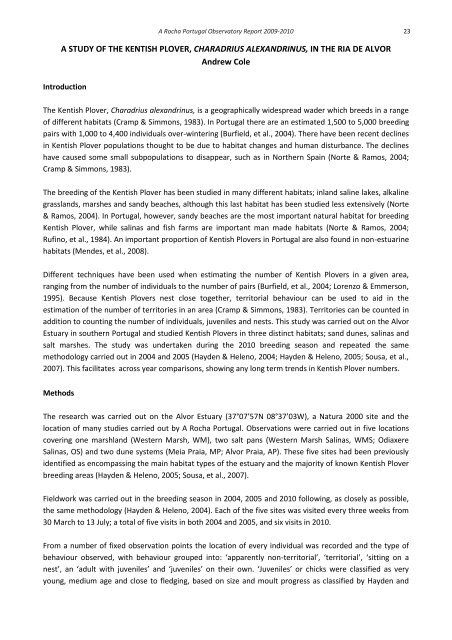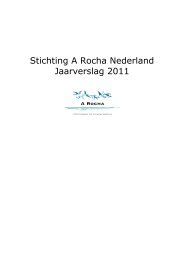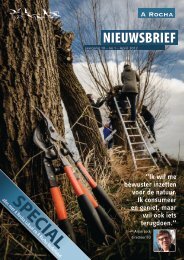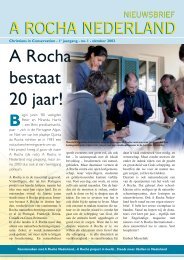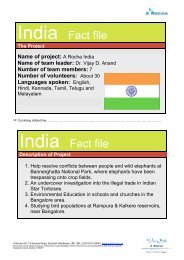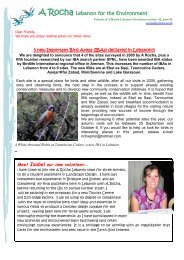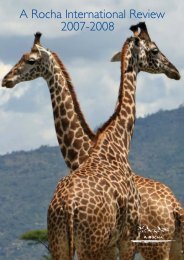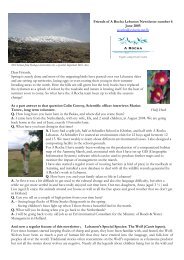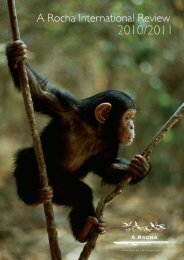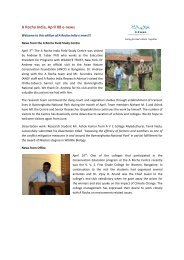A Rocha Portugal Observatory Report 2009-2010
A Rocha Portugal Observatory Report 2009-2010
A Rocha Portugal Observatory Report 2009-2010
Create successful ePaper yourself
Turn your PDF publications into a flip-book with our unique Google optimized e-Paper software.
A <strong>Rocha</strong> <strong>Portugal</strong> <strong>Observatory</strong> <strong>Report</strong> <strong>2009</strong>-<strong>2010</strong> 23<br />
A STUDY OF THE KENTISH PLOVER, CHARADRIUS ALEXANDRINUS, IN THE RIA DE ALVOR<br />
Andrew Cole<br />
Introduction<br />
The Kentish Plover, Charadrius alexandrinus, is a geographically widespread wader which breeds in a range<br />
of different habitats (Cramp & Simmons, 1983). In <strong>Portugal</strong> there are an estimated 1,500 to 5,000 breeding<br />
pairs with 1,000 to 4,400 individuals over-wintering (Burfield, et al., 2004). There have been recent declines<br />
in Kentish Plover populations thought to be due to habitat changes and human disturbance. The declines<br />
have caused some small subpopulations to disappear, such as in Northern Spain (Norte & Ramos, 2004;<br />
Cramp & Simmons, 1983).<br />
The breeding of the Kentish Plover has been studied in many different habitats; inland saline lakes, alkaline<br />
grasslands, marshes and sandy beaches, although this last habitat has been studied less extensively (Norte<br />
& Ramos, 2004). In <strong>Portugal</strong>, however, sandy beaches are the most important natural habitat for breeding<br />
Kentish Plover, while salinas and fish farms are important man made habitats (Norte & Ramos, 2004;<br />
Rufino, et al., 1984). An important proportion of Kentish Plovers in <strong>Portugal</strong> are also found in non-estuarine<br />
habitats (Mendes, et al., 2008).<br />
Different techniques have been used when estimating the number of Kentish Plovers in a given area,<br />
ranging from the number of individuals to the number of pairs (Burfield, et al., 2004; Lorenzo & Emmerson,<br />
1995). Because Kentish Plovers nest close together, territorial behaviour can be used to aid in the<br />
estimation of the number of territories in an area (Cramp & Simmons, 1983). Territories can be counted in<br />
addition to counting the number of individuals, juveniles and nests. This study was carried out on the Alvor<br />
Estuary in southern <strong>Portugal</strong> and studied Kentish Plovers in three distinct habitats; sand dunes, salinas and<br />
salt marshes. The study was undertaken during the <strong>2010</strong> breeding season and repeated the same<br />
methodology carried out in 2004 and 2005 (Hayden & Heleno, 2004; Hayden & Heleno, 2005; Sousa, et al.,<br />
2007). This facilitates across year comparisons, showing any long term trends in Kentish Plover numbers.<br />
Methods<br />
The research was carried out on the Alvor Estuary (37°07’57N 08°37’03W), a Natura 2000 site and the<br />
location of many studies carried out by A <strong>Rocha</strong> <strong>Portugal</strong>. Observations were carried out in five locations<br />
covering one marshland (Western Marsh, WM), two salt pans (Western Marsh Salinas, WMS; Odiaxere<br />
Salinas, OS) and two dune systems (Meia Praia, MP; Alvor Praia, AP). These five sites had been previously<br />
identified as encompassing the main habitat types of the estuary and the majority of known Kentish Plover<br />
breeding areas (Hayden & Heleno, 2005; Sousa, et al., 2007).<br />
Fieldwork was carried out in the breeding season in 2004, 2005 and <strong>2010</strong> following, as closely as possible,<br />
the same methodology (Hayden & Heleno, 2004). Each of the five sites was visited every three weeks from<br />
30 March to 13 July; a total of five visits in both 2004 and 2005, and six visits in <strong>2010</strong>.<br />
From a number of fixed observation points the location of every individual was recorded and the type of<br />
behaviour observed, with behaviour grouped into: ‘apparently non-territorial’, ‘territorial’, ‘sitting on a<br />
nest’, an ‘adult with juveniles’ and ‘juveniles’ on their own. ‘Juveniles’ or chicks were classified as very<br />
young, medium age and close to fledging, based on size and moult progress as classified by Hayden and


